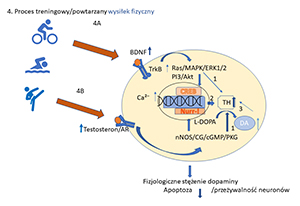Post-translational and post-transcriptional mechanisms of activity regulation of tyrosine hydroxylase in the central nervous system – the effect of physical exercise
DOI:
https://doi.org/10.18388/pb.2021_388Abstract
Numerous studies indicate that dopamine (DA) is an important regulator of motor, psychological and cognitive functions. Maintaining the appropriate concentration of DA is a condition for the proper functioning of these functions. Tyrosine hydroxylase is involved in the control of DA synthesis. The aim of this study is to discuss the regulation of TH activity with the participation of three main mechanisms: 1) post-translational immediate regulation by phosphorylation of various sites in the enzyme molecule and 2) post-transcriptional with the participation of transcription factors and specific miRNAs, and 3) a DA mediated feedback mechanism. Important factors which are directly or indirectly involved in these regulations of TH activity and DA concentration are BDNF, testosterone, alpha-synuclein and protein kinases.
A drastic reduction in DA levels in the extrapyramidal system causes drastic impairment of motor, psychological and cognitive functions. On the other hand, increased physical activity, in particular prolonged repetitive physical exercises by increasing the level of testosterone and BDNF in the blood, may activate signaling pathways dependent on them, increasing the activity of tyrosine hydroxylase, and thus increase the level of dopamine in the extrapyramidal system.

Published
Issue
Section
License
Copyright (c) 2021 Advances in Biochemistry

This work is licensed under a Creative Commons Attribution 4.0 International License.
All journal contents are distributed under the Creative Commons Attribution-ShareAlike 4.0 International (CC BY-SA 4.0) license. Everybody may use the content following terms: Attribution — You must give appropriate credit, provide a link to the license, and indicate if changes were made, ShareAlike — If you remix, transform, or build upon the material, you must distribute your contributions under the same license as the original. There are no additional restrictions — You may not apply legal terms or technological measures that legally restrict others from doing anything the license permits.
Copyright for all published papers © stays with the authors.
Copyright for the journal: © Polish Biochemical Society.



